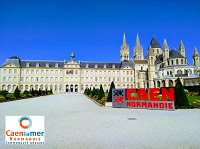Orateur
Description
Systematic studies of nuclear reactions are essential to the development of nuclear physics.
Understanding and predicting the evolution of nuclear structure and the novel phenomena in atomic nuclei has long been a pursuit of scientific curiosity.
Conventional methods such as charged particle probes, $\beta$-decay, Coulombic-excitation, and heavy-ion fusion evaporation reactions have been employed so far in the phase space of Shell structure, magic numbers, angular momentum, and excitation energy. However, the horizon of possibilities expands when we delve into the uncharted territories of fast-neutron probes. The (n,xn) reactions are a long-standing reaction mechanism used in the cross-section data evaluation, but rarely used in the framework of nuclear structure.
This might unveil a treasure trove of reactions, particularly the (n,xn) reactions with high production thresholds, which, until now, have not been looked at from the eye of nuclear structures.
As a result, we know very little about their reaction mechanisms.
While the structure of $^{56}$Ni has been previously investigated using charged particle and heavy ions collisions as shown in Fig.1.  , a pure neutron probe was never used.
, a pure neutron probe was never used.
For the first time, using the unprecedented neutron flux at $\sim$20 - 40 MeV at the Neutrons for Science (NFS) facility of GANIL--Spiral2, $^{56}$Ni can be populated from $^{58}$Ni in a (n,3n) reaction which has a cross-section of 2 mb at $\sim$30 MeV, opening a new probe and possibly new aspects of the nuclear structure of this doubly magic nucleus.
The TALYS cross-section calculation as a function of incident neutron energy is shown in Fig.2.  .
.
The maximum cross-section is predicted to be at 40 MeV, slightly higher than the end-point of NFS.
p + Li / Be allows reaching the [20-30] MeV range, whereas d + Be allows up to a broader [25-40] MeV range.
With $^{58}$Ni target, studying pure neutron channels is the main interest alongside Co isotopes that are produced from (n,p/d/t) reaction.
The nuclei near $^{56}$Ni are of particular interest as they are amenable to different microscopic theoretical treatments while studying the competition between single-particle and collective excitations. The collective states in $^{56}$Ni involve multiparticle multi-hole excitations across the $N=Z=28$ shell gap from the 1f$_{7/2}$ shell to the 2p$_{3/2}$, 1f$_{5/2}$, and 2p$_{1/2}$ orbits. Excitation to the higher lying 1g$_{9/2}$ orbit are necessary to explain the observed rotational bands in Cu and Zn. At high excitation energies, reaction studies have revealed evidence for hyper-deformed resonances in the $^{56}$Ni compound.
In this project, we performed prompt-$\gamma$ spectroscopy of $^{56}$Ni using the EXOGAM array at NFS.
From nuclear structure's point of view, the main motivation is the search for low spin (J=2 or 4) states from 3 to 10 MeV excitation energy possibly populating the $0^{+}$ states at 3956 keV, 6654 keV and 7903 keV observed only in $^{58}$Ni(p,t)$^{56}$Ni and $^{58}$Ni($^{3}$He,n)$^{56}$Ni reactions. New spectroscopic information that will be collected is also relevant for nuclear reaction mechanism formalism (like TALYS) and nuclear data evaluation libraries.
The experiment was carried out in October 2023. During an effective beam time of ~11 days, a high energy neutron beam produced by a primary beam of 10 $\mu$Amps of $^{2}$H, bombarded a 1mm thick Ni target.
The prompt gamma rays selected on the fastest neutron using the Time of Flight information have been detected by 12 EXOGAM clovers placed at 15 cm off the beam axis.
About $1.6 \times 10^{10}$ $\gamma\gamma$ coincidences have been sorted after the AddBack procedure.
The $^{56}$Ni decay was observed and a large number of $\gamma\gamma$ coincidences for $^{57}$Ni and Co isotopes were sorted.
The very preliminary analysis of the experiment, focusing mainly on the pure neutron channels, will be presented.
The (n,2n) channel that produces $^{57}$Ni has a much larger cross-section, reaching a maximum of $\sim$90 mb at around 23 MeV, making it easier to study. Additionally, $^{57}$Ni is only one neutron away from the doubly magic $^{56}$Ni, making spectroscopy of single particle, core-coupled, and collective states of great interest. The primary focus of the talk will be to provide a comprehensive description of its level scheme and excitation functions. This isotope has a half-life of 35.6 hours and undergoes $\beta^{+}$ decay to produce $^{57}$Co in the system, which interestingly is also populated by the (n,d) and (n,n$'$p) channels.
The question of whether large germanium volume detectors can be used for $\gamma$ spectroscopy in a high flux high neutron energy environment will also be addressed.
This experiment is a pioneering work in the study of the nuclear structure studies using large gamma array and fast neutron and is only possible at GANIL-Spiral2 as of today.
If successful, this program will open a new door for nuclear structure studies.

